Beauty contests became popular in the 1880s, but were not regarded as respectable. The pageants came to be considered more respectable with the first modern Miss America contest held in 1921. Beauty contests lead to many film careers. Some careers were tragically short, others were enduringly successful. Today EFSP presents 12 postcards of dazzling European beauty queens who acted in films.
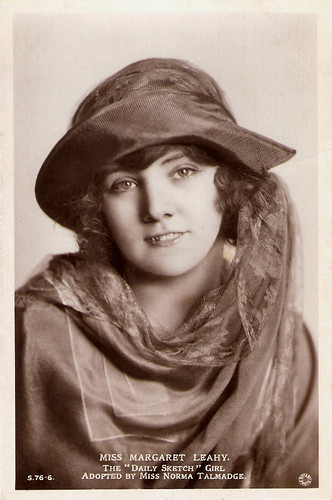
British postcard by Rotary Photo, London, no. 5.76. 6. Caption: The Daily Sketch girl. Adopted by Miss Norma Talmadge.
Margaret Leahy (1902–1967) won a beauty contest of the British Daily Sketch. In 1922, a starring role in a major Hollywood film was offered by the newspaper in a grand and widely publicised film star competition. The competition was to find a British actress to play second lead in Norma Talmadge's forthcoming Hollywood production Within The Law. The contestants reputably numbered nearly 80,000 and the competition resulted in three girls thought suitable: Katherine Campbell, the French Agnès Souret and Leahy. Prior to depart to Hollywood, Leahy toured several major cities in Europe and was greeted with hundreds of cheering fans and photographers as the new film star that was about to be born.
In Hollywood, Margaret Leahy began working with director Frank Lloyd who was going to make her a 'star.' Although it was said by her publicity that the young beauty queen had acted in English and French films, this proved to be highly untrue. Lloyd had her dismissed from Within the Law (1923). He claimed that Leahy could do nothing that an actress was supposed to be able to do. Following this, producer Joseph Schenck believed it did not take much to be a comedian, and handed Margaret over to his brother-in-law Buster Keaton to appear in his next comedy, the silent feature Three Ages (Edward F. Cline, Buster Keaton, 1923). Leahy's only film did absolutely nothing to improve her already crumbling film career. After the film finished shooting, there were no attempts to put her in any other films as she was labeled as being untalented and incapable of learning how to act. She went so far as to sue Joseph Schenck for $50,000 for breach of contract and injured feelings. Leahy chose to remain in California and get married, instead of returning to England.
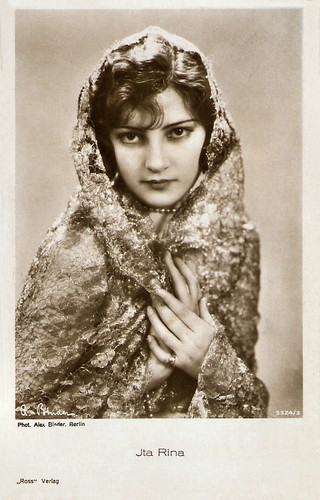
German postcard by Ross Verlag, no. 3324/3, 1928-1929. Photo: Alex Binder, Berlin.
Yugoslav film actress and beauty queen Ita Rina (1907-1979) was one of the major film stars in Germany and Czechoslovakia in the late 1920s and early 1930s. In October 1926, Slavic People magazine organised a beauty pageant for a Miss to represent Yugoslavia at the Miss Europe contest. The attractive nineteen-year-old Rina secretly entered the beauty contest, not telling anyone at home. She was crowned Miss Slovenia and should travel to the final event for Miss Yugoslavia in Zagreb. Then her mother forbade her go to Zagreb. However, she was noticed by Adolf Müller, the owner of Balkan Palace cinema in Zagreb. He sent her photographs to German film producer Peter Ostermayer, who invited her to come to Germany. As her mother did not want to let her go to Berlin, Rina ran away from home and arrived in Berlin in 1927. After her first audition, she had classes in acting, diction, dancing, driving and riding.
Ita Rina made her film debut in the leading role in Was die Kinder ihren Eltern verschweigen/What Do Children Hide from Their Parents (Franz Osten, 1927) with Mary Johnson. The critics noticed her in Das letzte Souper/The Last Supper (Mario Bonnard, 1928). Her big breakthrough came the following year in Erotikon/Seduction (1929), directed by Gustav Machatý. The film was a great success but also upset some moral and Christian organizations. In 1931, Ita Rina earned 15,000 marks per month and was an idol to teenagers as well as modern emancipated women. The same year, Rina was given an offer from Hollywood, but her husband forced her to choose between her career and their marriage; Rina chose to stay with him. Although she had announced her retirement from the cinema, she acted until the outbreak of the World War II.
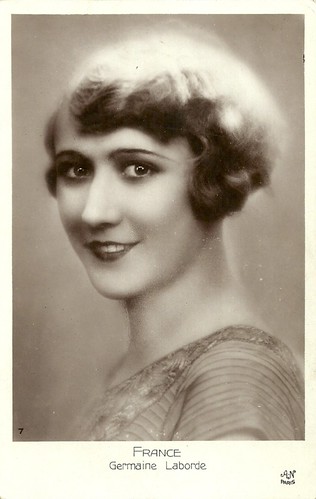
French postcard by A.N., Paris. Caption: France - Germaine Laborde
Germaine Laborde was Miss France 1928, after being elected Miss Gascogne in 1927. She joined the 1929 Miss Europe contest but didn't win; she became third after Hungary and Poland. On her return to France, Mlle. Laborde played with Mistinguett at the Casino de Paris in the revue, Paris-Miss. Laborde also acted in the film Chacun sa chance by René Pujol and Hanns Steinhoff, starring Renée Heribel and Jean Gabin. Her career didn't last very long and she became a nanny.
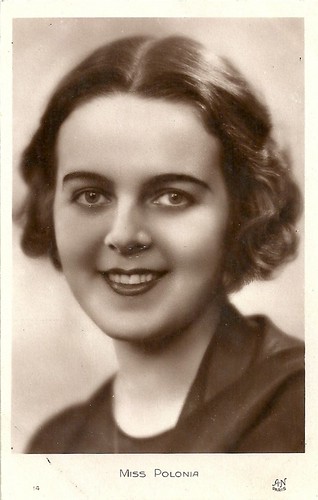
French postcard by A.N., Paris, no. 14. Caption: Miss Polonia.
Polish model and actress Zofia Batycka (1907-1989) studied at the Warsaw School of Economics. She supposedly had an affair with tenor Jan Kiepura in 1928 but they never married. As a student Zofia made her debut in the cinema. From 1929 on she played in Polish films, first in the silent Sfinks production Grzeszna milosc (Zbigniew Gniazdowski, Mieczyslaw Krawicz, 1929), partly filmed at the Tatra Mountains. It was followed by the silent films Szlakiem hanby/Export in Blond (Mieczyslaw Krawicz, Alfred Niemirski, 1929) and Dusze w niewoli/Souls in Bondage (Leon Trystan, 1930). Moralnosc pani Dulskiej (Boleslaw Newolin, 1930) was probably her first sound film. It was followed by the short sound film Kobieta, która sie smieje (Ryszard Ordynski, 1931) which was shot at the Paris Paramount sound studios, and the sound feature Dziesieciu z Pawiaka/10 Condemned (Ryszard Ordynski, 1931).
When Zofia Batycka won the title of Miss Polonia 1930, she became extremely popular. She joined the Miss Europe 1930 contest in Paris. Winner that year was Miss Greece Aliki Diplarakou. Batycka went on to win the title of Miss Paramount in 1931 and went to Hollywood in hope of a film career there. While away, Miss Poland 1931 couldn't go through as Batycka had forgotten to hand over the temporary crown. In 1932, Batycka signed with the American label International Artists. It proved to be completely unsuccessful - in fact she didn't do any movies in Hollywood. In 1934 she returned to Poland and for a time there she worked as a theatre actress. Soon she gave up acting and married. After the war she moved to the United States and settled in Los Angeles. After her husband's death and that of her mother, she maintained herself by teaching foreign languages (she mastered four languages), and then worked in a gallery. She died in obscurity in 1989.

French postcard by A.N., Paris, no. 1c. Photo: St. Mano. Caption: Miss Europa - France.
Jeanne Juilla was elected Miss Garonne in 1930 and Miss France in 1931, so she joined the Miss Europe 1931 pageant ... and won. Juilla worked as fashion model, and was photographed by Dora Kalmus for L'Officiel de la Mode in 1933. She also played supporting acts in some films: Sa meilleure cliente (Pierre Colombier, 1932) starring Elvire Popesco, La prison de Sainte Clothaire (Pierre-Jean Ducis, 1933) in which Juilla played a bar owner, Une femme chipée (Pierre Colombier, 1934), and Samson (Maurice Tourneur, 1936) with Harry Baur.

French postcard by A.N., Paris, no. 2A. Photo: St. Mano. Caption: Miss Austria.
The Austrian representative at the Miss Europe 1931 pageant was Hertha van Haentjens. After the Parisian contest, Van Haentjens got the lead in an Austrian early sound film film, Wiener Zauberklänge/Viennese Magic Tunes (Robert Reich, 1931), opposite Wolf Albach-Retty.
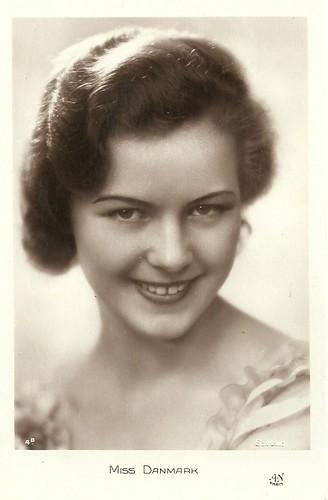
French postcard by A.N., Paris. Photo: St. Mano. Caption: Miss Denmark.
Danish representative for the Miss Europe 1931 pageant was Inga Arvad (1913-1973). Arvad was the 1931 beauty queen selected by the Danish newspaper Berlingske Tidende. After the pageant she appeared in two Danish films, the little known Storm Varsel and Flugten fra millionerne/Flight from the Millions (Pál Fejös, 1934). She started to work as a journalist and interviewed Adolf Hitler and was his companion at the 1936 Summer Olympics.
In 1939 Inga Arvad moved to the U.S. and had a romantic relationship with John F. Kennedy during 1941 and 1942. This led to suspicions that she was a Nazi spy, but investigations uncovered no such evidence. In the U.S., she worked as a motion picture writer for Metro-Goldwyn-Mayer and a Hollywood gossip columnist. Arvad's first husband was Kamal Abdel Nabi, whom she married in 1931, when she was 17. Her second husband was Hungarian film director Pál Fejös or Paul Fejos. From 1945 until her death she was the wife of wealthy cowboy actor and military officer Tim McCoy.
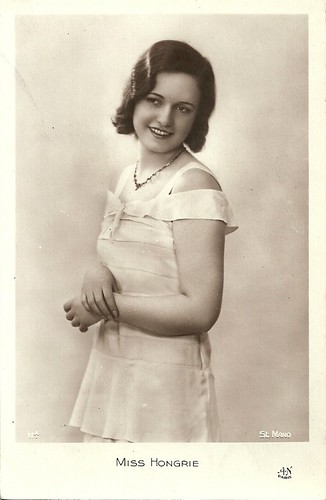
French postcard by A.N., Paris, no. 11A. Photo: St. Mano. Caption: Miss Hongrie.
Hungary's representative at the Miss Europe 1931 pageant was Maria Tasnady-Fekete (1911-2001), who later became well known as singer, stage and film actress Maria von Tasnady. After the Miss Europe pageant, Maria moved to Weimar Germany, where she made her film debut in 1932 in Durchlaucht amusiert sich (Conrad Wiene, 1932) with Georg Alexander. She made several German films such as Douglas Sirk's Schlussakkord (1936) in which she had the lead. Later, she also worked in her native Hungary and in Italy where she appeared in the patriotic war film Bengasi (Augusto Genina, 1942) with Fosco Giachetti.
All in all, Maria von Tasnady appeared in 25 films during her career. Following the Second World War, she was employed by Radio Free Europe, and played in three more three films, e.g. as Caruso's mother in Enrico Caruso - Leggenda di una voce/The Young Caruso (Giacomo Gentilomo, 1951). She retired in the late 1950s. Maria von Tasnady was married to the film producer Bruno Duday.
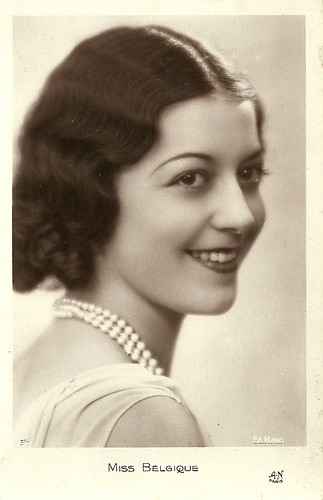
French postcard by A.N., Paris, no. 3B. Photo: St. Mano. Caption: Miss Belgique.
Belgium's representative at the Miss Europe 1931 pageant was Annette 'Netta' Duchateau (1910-1994). She became Miss Namur and subsequently Miss Belgium in 1930, joined in the Miss Europe contest in Paris and became Miss Universe in Galveston in 1931 at the age of 20. She was the first Miss Belgium to obtain that title.
In 1932 Annette Duchateau started a modest career in cinema, playing a small part in her only film, Grains de beauté (Pierre Caron, 1932) with Roger Tréville. After that she became stage actress. During the war she played in Ces dames aux chapeaux verts in Paris. After that she acted in the Brussels theatres, e.g. as Roxane in Cyrano de Bergerac. At the end of her career she emigrated to France, then Monaco, where she died at the age of 83. Supposedly she inspired Sterne Stevens for his design for Miss Belga cigarettes.

French postcard by Editions P.I., Paris, no. FK 3814. Photo: Arthur Grimm / Ufa.
Austrian actress Nadja Tiller (1929) started out as a model. She won the Miss Austria contest twice, in 1949 and 1951, which turned out to be her ticket into filmmaking. In 1949, she acted opposite O.W. Fischer in Märchen vom Glück (Arthur de Glahs, 1949). Many roles as a vamp in German and Austrian films followed. In 1954 she worked with director Rolf Thiele in the successful Sie. Until 1970 they would make ten more movies together, including Die Barrings (1955), and Lulu (1962), with Mario Adorf.
Nadja Tiller’s international breakthrough role was that of the high class prostitute Rosemarie Nitribitt in Das Mädchen Rosemarie (Rolf Thiele, 1958). The film, based on a scandal, confirmed the assumption of post-war, American audiences that European actresses were somehow more sensuous and erotic than their Hollywood counterparts. With international productions like The Rough and the Smooth (Robert Siodmak, 1959), Du Rififi chez les femmes (Alex Joffé, 1959), and Anima nera (Roberto Rossellini, 1962), Tiller stayed a favourite of the art house public. She would act in more than 70 films.
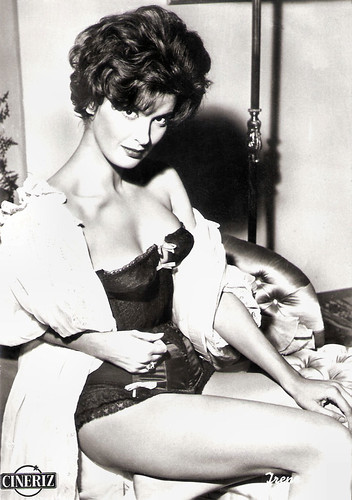
Italian postcard by Bromofoto, Milano (Milan), no. 1656. Photo: Cineriz.
Sexy French actress and model Irène Tunc (1935-1972) was chosen Miss Côte d'Azur 1953 in the beach town of Juan-les-Pins. At the time, she was already working as a mannequin, modeling for local papers and posing in beachwear for holiday postcards. The next year, she was crowned Miss France in 1954 at the age of 19. One of her first film roles was opposite Franco Fabrizi and Gabriele Ferzetti in the Italian comedy-drama Camilla (Luciano Emmer, 1954). In Italy, she also appeared with Alberto Sordi in Bravissimo (Luigi Filippo D'Amico, 1955). Back in France, she continued to model in Paris and studied acting at the school of Françoise Rosay. After a few small parts in French films, she returned to Italy for better roles. She played the lead role in the melodrama La sposa/The wife (Edmondo Lozzi, 1958), and a supporting part in the crime-comedy Noi siamo due evasi (Giorgio Simonelli, 1959).
Irène Tunc found more rewarding roles in the French cinema with the raise of the Nouvelle Vague. She had a big supporting part in the classic Léon Morin, prêtre/Léon Morin, Priest/The Sin (Jean-Pierre Melville, 1961), starring Jean-Paul Belmondo. Also memorable is Vivre pour vivre/Live for Life (Claude Lelouch, 1967), starring Yves Montand. Irène Tunc died in a car crash in 1972 in Versailles She was only 36.
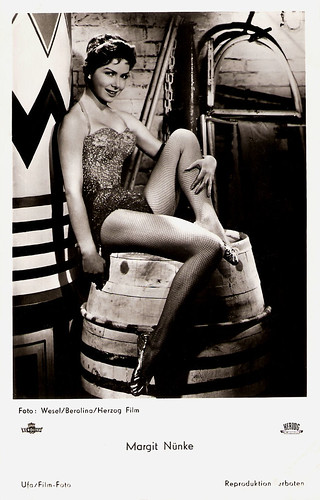
German postcard by Ufa, Berlin-Tempelhof, no. FK 3615. Photo: Wesel / Berolina / Herzog Film. Publicity still for Das haut hin/The skin-out (Géza von Cziffra, 1957).
Gorgeous German actress Margit Nünke (1930) became Miss Germany in 1955 after previously being Miss North Rhine-Westphalia. The following year, 1956, she won the Miss Europe pageant in Stockholm before 12 other candidates and in front of 5,000 spectators. Finally, she reached the 4th place at the Miss Universe contest in Long Beach, USA, in 1958. From 1957 on she appeared in feature films and TV movies. In Italy, she acted opposite Rik Battaglia in I fidanzati della morte/The betrothed of death (Romolo Marcellini, 1957). In the German musical comedy Das haut hin/The skin-out (Géza von Cziffra, 1957) she appeared opposite the popular Peter Alexander. In the Austrian film Geliebte Bestie/Arena of Fear (Arthur Maria Rabenalt, 1959), she put her dancing skills to the test.
In the next decade, Margit Nünke continued to appear in German lighter-than-light entertainment films with such film partners as Walter Giller and Toni Sailer. Titles include the Conny Froboess comedy Meine Nichte tut das nicht/My Niece Doesn't Do That (Franz Josef Gottlieb, 1960), and Liebesgrüße aus Tirol/With Love from Tyrol (Franz Antel, 1964) with Peter Weck. As a singer, she recorded several singles, including the duet Jede Woche, die hat 7 Tage (Every week has 7 days) with her husband Peter Garden. Together, they performed in his TV-series Garden-Party (1969-1970).
This is a post for Postcard Friendship Friday, hosted by Beth at the The Best Hearts are Crunchy. You can visit her by clicking on the button below.

Sources: Filmpolski.pl, Wikipedia and IMDb.

British postcard by Rotary Photo, London, no. 5.76. 6. Caption: The Daily Sketch girl. Adopted by Miss Norma Talmadge.
Margaret Leahy (1902–1967) won a beauty contest of the British Daily Sketch. In 1922, a starring role in a major Hollywood film was offered by the newspaper in a grand and widely publicised film star competition. The competition was to find a British actress to play second lead in Norma Talmadge's forthcoming Hollywood production Within The Law. The contestants reputably numbered nearly 80,000 and the competition resulted in three girls thought suitable: Katherine Campbell, the French Agnès Souret and Leahy. Prior to depart to Hollywood, Leahy toured several major cities in Europe and was greeted with hundreds of cheering fans and photographers as the new film star that was about to be born.
In Hollywood, Margaret Leahy began working with director Frank Lloyd who was going to make her a 'star.' Although it was said by her publicity that the young beauty queen had acted in English and French films, this proved to be highly untrue. Lloyd had her dismissed from Within the Law (1923). He claimed that Leahy could do nothing that an actress was supposed to be able to do. Following this, producer Joseph Schenck believed it did not take much to be a comedian, and handed Margaret over to his brother-in-law Buster Keaton to appear in his next comedy, the silent feature Three Ages (Edward F. Cline, Buster Keaton, 1923). Leahy's only film did absolutely nothing to improve her already crumbling film career. After the film finished shooting, there were no attempts to put her in any other films as she was labeled as being untalented and incapable of learning how to act. She went so far as to sue Joseph Schenck for $50,000 for breach of contract and injured feelings. Leahy chose to remain in California and get married, instead of returning to England.

German postcard by Ross Verlag, no. 3324/3, 1928-1929. Photo: Alex Binder, Berlin.
Yugoslav film actress and beauty queen Ita Rina (1907-1979) was one of the major film stars in Germany and Czechoslovakia in the late 1920s and early 1930s. In October 1926, Slavic People magazine organised a beauty pageant for a Miss to represent Yugoslavia at the Miss Europe contest. The attractive nineteen-year-old Rina secretly entered the beauty contest, not telling anyone at home. She was crowned Miss Slovenia and should travel to the final event for Miss Yugoslavia in Zagreb. Then her mother forbade her go to Zagreb. However, she was noticed by Adolf Müller, the owner of Balkan Palace cinema in Zagreb. He sent her photographs to German film producer Peter Ostermayer, who invited her to come to Germany. As her mother did not want to let her go to Berlin, Rina ran away from home and arrived in Berlin in 1927. After her first audition, she had classes in acting, diction, dancing, driving and riding.
Ita Rina made her film debut in the leading role in Was die Kinder ihren Eltern verschweigen/What Do Children Hide from Their Parents (Franz Osten, 1927) with Mary Johnson. The critics noticed her in Das letzte Souper/The Last Supper (Mario Bonnard, 1928). Her big breakthrough came the following year in Erotikon/Seduction (1929), directed by Gustav Machatý. The film was a great success but also upset some moral and Christian organizations. In 1931, Ita Rina earned 15,000 marks per month and was an idol to teenagers as well as modern emancipated women. The same year, Rina was given an offer from Hollywood, but her husband forced her to choose between her career and their marriage; Rina chose to stay with him. Although she had announced her retirement from the cinema, she acted until the outbreak of the World War II.

French postcard by A.N., Paris. Caption: France - Germaine Laborde
Germaine Laborde was Miss France 1928, after being elected Miss Gascogne in 1927. She joined the 1929 Miss Europe contest but didn't win; she became third after Hungary and Poland. On her return to France, Mlle. Laborde played with Mistinguett at the Casino de Paris in the revue, Paris-Miss. Laborde also acted in the film Chacun sa chance by René Pujol and Hanns Steinhoff, starring Renée Heribel and Jean Gabin. Her career didn't last very long and she became a nanny.

French postcard by A.N., Paris, no. 14. Caption: Miss Polonia.
Polish model and actress Zofia Batycka (1907-1989) studied at the Warsaw School of Economics. She supposedly had an affair with tenor Jan Kiepura in 1928 but they never married. As a student Zofia made her debut in the cinema. From 1929 on she played in Polish films, first in the silent Sfinks production Grzeszna milosc (Zbigniew Gniazdowski, Mieczyslaw Krawicz, 1929), partly filmed at the Tatra Mountains. It was followed by the silent films Szlakiem hanby/Export in Blond (Mieczyslaw Krawicz, Alfred Niemirski, 1929) and Dusze w niewoli/Souls in Bondage (Leon Trystan, 1930). Moralnosc pani Dulskiej (Boleslaw Newolin, 1930) was probably her first sound film. It was followed by the short sound film Kobieta, która sie smieje (Ryszard Ordynski, 1931) which was shot at the Paris Paramount sound studios, and the sound feature Dziesieciu z Pawiaka/10 Condemned (Ryszard Ordynski, 1931).
When Zofia Batycka won the title of Miss Polonia 1930, she became extremely popular. She joined the Miss Europe 1930 contest in Paris. Winner that year was Miss Greece Aliki Diplarakou. Batycka went on to win the title of Miss Paramount in 1931 and went to Hollywood in hope of a film career there. While away, Miss Poland 1931 couldn't go through as Batycka had forgotten to hand over the temporary crown. In 1932, Batycka signed with the American label International Artists. It proved to be completely unsuccessful - in fact she didn't do any movies in Hollywood. In 1934 she returned to Poland and for a time there she worked as a theatre actress. Soon she gave up acting and married. After the war she moved to the United States and settled in Los Angeles. After her husband's death and that of her mother, she maintained herself by teaching foreign languages (she mastered four languages), and then worked in a gallery. She died in obscurity in 1989.

French postcard by A.N., Paris, no. 1c. Photo: St. Mano. Caption: Miss Europa - France.
Jeanne Juilla was elected Miss Garonne in 1930 and Miss France in 1931, so she joined the Miss Europe 1931 pageant ... and won. Juilla worked as fashion model, and was photographed by Dora Kalmus for L'Officiel de la Mode in 1933. She also played supporting acts in some films: Sa meilleure cliente (Pierre Colombier, 1932) starring Elvire Popesco, La prison de Sainte Clothaire (Pierre-Jean Ducis, 1933) in which Juilla played a bar owner, Une femme chipée (Pierre Colombier, 1934), and Samson (Maurice Tourneur, 1936) with Harry Baur.

French postcard by A.N., Paris, no. 2A. Photo: St. Mano. Caption: Miss Austria.
The Austrian representative at the Miss Europe 1931 pageant was Hertha van Haentjens. After the Parisian contest, Van Haentjens got the lead in an Austrian early sound film film, Wiener Zauberklänge/Viennese Magic Tunes (Robert Reich, 1931), opposite Wolf Albach-Retty.

French postcard by A.N., Paris. Photo: St. Mano. Caption: Miss Denmark.
Danish representative for the Miss Europe 1931 pageant was Inga Arvad (1913-1973). Arvad was the 1931 beauty queen selected by the Danish newspaper Berlingske Tidende. After the pageant she appeared in two Danish films, the little known Storm Varsel and Flugten fra millionerne/Flight from the Millions (Pál Fejös, 1934). She started to work as a journalist and interviewed Adolf Hitler and was his companion at the 1936 Summer Olympics.
In 1939 Inga Arvad moved to the U.S. and had a romantic relationship with John F. Kennedy during 1941 and 1942. This led to suspicions that she was a Nazi spy, but investigations uncovered no such evidence. In the U.S., she worked as a motion picture writer for Metro-Goldwyn-Mayer and a Hollywood gossip columnist. Arvad's first husband was Kamal Abdel Nabi, whom she married in 1931, when she was 17. Her second husband was Hungarian film director Pál Fejös or Paul Fejos. From 1945 until her death she was the wife of wealthy cowboy actor and military officer Tim McCoy.

French postcard by A.N., Paris, no. 11A. Photo: St. Mano. Caption: Miss Hongrie.
Hungary's representative at the Miss Europe 1931 pageant was Maria Tasnady-Fekete (1911-2001), who later became well known as singer, stage and film actress Maria von Tasnady. After the Miss Europe pageant, Maria moved to Weimar Germany, where she made her film debut in 1932 in Durchlaucht amusiert sich (Conrad Wiene, 1932) with Georg Alexander. She made several German films such as Douglas Sirk's Schlussakkord (1936) in which she had the lead. Later, she also worked in her native Hungary and in Italy where she appeared in the patriotic war film Bengasi (Augusto Genina, 1942) with Fosco Giachetti.
All in all, Maria von Tasnady appeared in 25 films during her career. Following the Second World War, she was employed by Radio Free Europe, and played in three more three films, e.g. as Caruso's mother in Enrico Caruso - Leggenda di una voce/The Young Caruso (Giacomo Gentilomo, 1951). She retired in the late 1950s. Maria von Tasnady was married to the film producer Bruno Duday.

French postcard by A.N., Paris, no. 3B. Photo: St. Mano. Caption: Miss Belgique.
Belgium's representative at the Miss Europe 1931 pageant was Annette 'Netta' Duchateau (1910-1994). She became Miss Namur and subsequently Miss Belgium in 1930, joined in the Miss Europe contest in Paris and became Miss Universe in Galveston in 1931 at the age of 20. She was the first Miss Belgium to obtain that title.
In 1932 Annette Duchateau started a modest career in cinema, playing a small part in her only film, Grains de beauté (Pierre Caron, 1932) with Roger Tréville. After that she became stage actress. During the war she played in Ces dames aux chapeaux verts in Paris. After that she acted in the Brussels theatres, e.g. as Roxane in Cyrano de Bergerac. At the end of her career she emigrated to France, then Monaco, where she died at the age of 83. Supposedly she inspired Sterne Stevens for his design for Miss Belga cigarettes.

French postcard by Editions P.I., Paris, no. FK 3814. Photo: Arthur Grimm / Ufa.
Austrian actress Nadja Tiller (1929) started out as a model. She won the Miss Austria contest twice, in 1949 and 1951, which turned out to be her ticket into filmmaking. In 1949, she acted opposite O.W. Fischer in Märchen vom Glück (Arthur de Glahs, 1949). Many roles as a vamp in German and Austrian films followed. In 1954 she worked with director Rolf Thiele in the successful Sie. Until 1970 they would make ten more movies together, including Die Barrings (1955), and Lulu (1962), with Mario Adorf.
Nadja Tiller’s international breakthrough role was that of the high class prostitute Rosemarie Nitribitt in Das Mädchen Rosemarie (Rolf Thiele, 1958). The film, based on a scandal, confirmed the assumption of post-war, American audiences that European actresses were somehow more sensuous and erotic than their Hollywood counterparts. With international productions like The Rough and the Smooth (Robert Siodmak, 1959), Du Rififi chez les femmes (Alex Joffé, 1959), and Anima nera (Roberto Rossellini, 1962), Tiller stayed a favourite of the art house public. She would act in more than 70 films.

Italian postcard by Bromofoto, Milano (Milan), no. 1656. Photo: Cineriz.
Sexy French actress and model Irène Tunc (1935-1972) was chosen Miss Côte d'Azur 1953 in the beach town of Juan-les-Pins. At the time, she was already working as a mannequin, modeling for local papers and posing in beachwear for holiday postcards. The next year, she was crowned Miss France in 1954 at the age of 19. One of her first film roles was opposite Franco Fabrizi and Gabriele Ferzetti in the Italian comedy-drama Camilla (Luciano Emmer, 1954). In Italy, she also appeared with Alberto Sordi in Bravissimo (Luigi Filippo D'Amico, 1955). Back in France, she continued to model in Paris and studied acting at the school of Françoise Rosay. After a few small parts in French films, she returned to Italy for better roles. She played the lead role in the melodrama La sposa/The wife (Edmondo Lozzi, 1958), and a supporting part in the crime-comedy Noi siamo due evasi (Giorgio Simonelli, 1959).
Irène Tunc found more rewarding roles in the French cinema with the raise of the Nouvelle Vague. She had a big supporting part in the classic Léon Morin, prêtre/Léon Morin, Priest/The Sin (Jean-Pierre Melville, 1961), starring Jean-Paul Belmondo. Also memorable is Vivre pour vivre/Live for Life (Claude Lelouch, 1967), starring Yves Montand. Irène Tunc died in a car crash in 1972 in Versailles She was only 36.

German postcard by Ufa, Berlin-Tempelhof, no. FK 3615. Photo: Wesel / Berolina / Herzog Film. Publicity still for Das haut hin/The skin-out (Géza von Cziffra, 1957).
Gorgeous German actress Margit Nünke (1930) became Miss Germany in 1955 after previously being Miss North Rhine-Westphalia. The following year, 1956, she won the Miss Europe pageant in Stockholm before 12 other candidates and in front of 5,000 spectators. Finally, she reached the 4th place at the Miss Universe contest in Long Beach, USA, in 1958. From 1957 on she appeared in feature films and TV movies. In Italy, she acted opposite Rik Battaglia in I fidanzati della morte/The betrothed of death (Romolo Marcellini, 1957). In the German musical comedy Das haut hin/The skin-out (Géza von Cziffra, 1957) she appeared opposite the popular Peter Alexander. In the Austrian film Geliebte Bestie/Arena of Fear (Arthur Maria Rabenalt, 1959), she put her dancing skills to the test.
In the next decade, Margit Nünke continued to appear in German lighter-than-light entertainment films with such film partners as Walter Giller and Toni Sailer. Titles include the Conny Froboess comedy Meine Nichte tut das nicht/My Niece Doesn't Do That (Franz Josef Gottlieb, 1960), and Liebesgrüße aus Tirol/With Love from Tyrol (Franz Antel, 1964) with Peter Weck. As a singer, she recorded several singles, including the duet Jede Woche, die hat 7 Tage (Every week has 7 days) with her husband Peter Garden. Together, they performed in his TV-series Garden-Party (1969-1970).
This is a post for Postcard Friendship Friday, hosted by Beth at the The Best Hearts are Crunchy. You can visit her by clicking on the button below.

Sources: Filmpolski.pl, Wikipedia and IMDb.
No comments:
Post a Comment